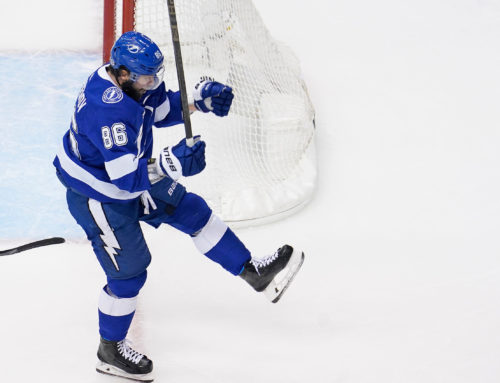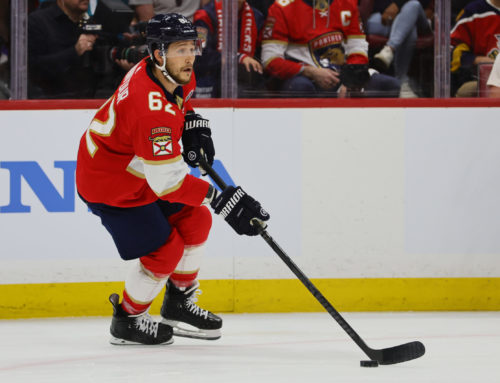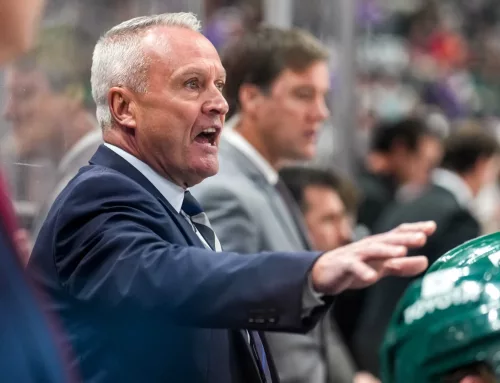Ramblings: GAME 7!; Sergachev; Vrana; Kane; Armia; Power-Play Defencemen – May 24
Michael Clifford
2018-05-24

We had a very spirited start to Game 7 of the Eastern Conference Final. It really, really was a great series, honestly. Both goaltenders were excellent, the action was back and forth, and, of course, it gave us a Game 7.
Not that it should shock anyone, but Alex Ovechkin got the scoring in this game. Just over a minute in, he unleashed a rocket from his office but for a chance of pace, it was at five-on-five:
.@ovi8 with a rocket to give the @Capitals an early lead. pic.twitter.com/G5YosWs5wx
— NHL GIFs (@NHLGIFs) May 24, 2018
The rest of the first period saw some good chances for both teams but the needle leaning to Tampa. We even got a good bout between Braydon Coburn and Tom Wilson.
Andre Burakovsky made the real difference in the game in the second period. Lightning defenceman Dan Girardi flubbed an aerial puck that led to a Burakovsky breakaway, one which he promptly converted for a 2-0 lead. With under four minutes left in the frame, Burakovsky got another breakaway off a bad change by the Lightning blue line and he again converted to make it 3-0. A good time to get your first two goals of the playoffs, to say the least.
At that point, with Braden Holtby locking things down in goal, it was all academic and Washington advanced to their first Cup Final in 20 years.
It was a great moment for Ovechkin, a guy unfairly maligned by media and fans for years, finally getting his crack at hockey’s Holy Grail. Also a great redemption for Holtby, who’d not played well at times this year and wasn’t even the starting goalie for the Caps at the beginning of the postseason.
On the Tampa side, this is a team built to be Cup-or-bust. Considering how hard it is to win it all, losing a Game 7 of a Conference Final seems hardly like a bust, but they are truly among the elite in the league. Like Winnipeg, this team has all pertinent players locked up for next year and guys like Sergachev and Point will only get better. We’ll hear from them again next playoffs.
Kudos to the Caps and their fans. The last decade has been torturous considering how elite the teams have been in the regular season only to be followed consistently by playoff letdowns. They’ve earned this moment and it sets up a wonderful Cup Final.
*
The impending Evander Kane extension is an interesting case in this sense: can he stay healthy?
Being able to stay on the ice is important, especially for fantasy. Having to replace a 30-goal scorer with a waiver wire replacement once in a while is fine. Having to do it for a dozen games can be an issue unless you strike lightning in a bottle. His 78 games last year are a career high. Over the last five seasons, he’s missed 23.7 percent of games, which means he’s averaged about 63 games played over those seasons. That’s not nearly good enough. If he can play 80 games, playing with a top-tier centre like Joe Pavelski or Joe Thornton (or both!), then he’s 30 goals and 60 points in the making. If that’s 65 games? Not so much.
Given how well he played with San Jose after the trade, both regular season and playoffs, he won’t be a sleeper at the draft table. We’ll see where his ADP falls, but I’ll probably be out on him for 2018-19.
*
At the risk of sounding like a broken record, Jakub Vrana’s individual expected goals per 60 minutes these playoffs (going into Game 7) is 0.91, 10th among forwards with 150 minutes at five-on-five. That mark is ahead of names like James Neal, Jonathan Marchessault, and Rick Nash. The problem is he’s shooting 3.85 percent at five-on-five so the actual production hasn’t been there.
Just add this to the mounting evidence that Vrana will be (or already is) a pretty good player. Upside is capped without the top power-play minutes but he is a guy who will litter my fantasy rosters come September.
*
Heading into Wednesday night’s Game 7, there were 93 forwards with at least 100 minutes of five-on-five ice time in these playoffs. Any guesses on which of those 93 forwards had the highest rate of shot attempts per 60 minutes?
You’d have to guess about 50 players. It’s Winnipeg forward Joel Armia.
Not that there could be much fantasy relevance next year. Barring injury, Winnipeg’s top-9 forward mix could be Connor-Scheifele-Wheeler, Laine-Little-Ehlers, Perreault-Lowry-Roslovic. Not much space for Armia to break through. It’s easy to forget that he was a mid-first rounder and will just be 25 years old next year. Maybe he can move up the lineup if there’s a serious injury or two but I just found it curious he had such a high shot rate in the postseason. That fourth line for Winnipeg played pretty well, which is good news for next year.
*
An interesting note from Dimitri Filipovic of Sportsnet with regards to controlled zone exit percentage in the Conference Finals among blue liners:
It's only a handful of games worth of data, but for those that are interested here are the updated zone exit numbers for defensemen in these Conference Finals. pic.twitter.com/feYbtmGmcq
📢 advertisement:— Dimitri Filipovic (@DimFilipovic) May 23, 2018
Mikhail Sergachev: hoo boy.
This is a guy with a 40-point season as a teenager while putting up top-10 shot rates among defencemen. His future is incredibly bright and it’s good to see the pressure of the playoffs isn’t getting to him. He’s still playing his game and playing it well.
*
My last several Ramblings have been discussing shot rates. This whole series really goes back a month or so, but this last 10 days has been focused on changing shot rates at five-on-five and on the power play. Here is what has been covered so far:
- Shot distribution from defencemen at 5v5
- Shot distribution from forwards at 5v5
- Rise in shot rates at 5v5
- Decline in share of goals by defencemen on the PP
- Decline in share of TOI by defencemen on the PP
There are a couple things worth discussing now: shot rates and assist rates among defencemen on the power play.
As noted in one of the links above, power-play minutes allocation to blue liners has declined with the rise in four forward/one defenceman PP units. With it has been a commensurate decline in shot totals and goal scoring. There are fewer shots but are the defencemen who are given power-play minutes shooting less? And if they are, does that make them facilitators rather than the triggermen? Let’s dive in.
First thing to point out: defencemen are shooting more on the power play. There was a huge jump in shot attempts per 60 minutes on the PP back in 2014-15 and then small increases every season since:

Power plays at the team level were kind of the mirror opposite of what happened with defencemen. Rather than a jump in shot rates a few years ago with steady increase the last few seasons, there was a steady increase a few seasons ago and a big jump last year. This is what the trend looks like for shot attempts per 60 minutes at the league-wide level on the power play since 2013-14:

What does this tell us for defencemen? That even though league-wide shot attempt rates on the power play rose, on average, by 4.4 percent, the average shot rates from defencemen only rose by 0.4 percent. While defencemen in 2017-18 are shooting a lot more than they were in 2013-14, compared to just last season, their involvement with putting pucks on net for the power play specifically has declined. Keep in mind that this isn’t total shots; we know that with more teams moving to a setup with four forwards and one defenceman that total shot rates would decline. This is the average shot attempt rate by a given defenceman on the power play. Even though goals per 60 minutes by teams on the power play rose 7.2 percent between 2016-17 and 2017-18, goals per 60 minutes by defencemen on the power play rose just over 1 percent.
So we have defencemen playing less but shooting more in the minutes that are given, yet not shooting as much as the increase in league-wide trends. It’s the forwards shooting more often on a rate basis. Does that mean defencemen are becoming less important on the power play? Not at all, really.
Here are primary assist rates per 60 minutes on the power play by defencemen in every season since 2013-14. It’s… something:

The primary assist rate on the power play for defencemen in 2016-17 was 1.35 and that exploded to 1.67 in 2017-18, an increase of a whopping 23.7 percent. When you think of a 4F-1D, 1-3-1 setup, it makes sense: it’s not really a setup for defencemen to bomb shots from the point. It’s a setup to give the defenceman options, which truly makes him the PP quarterback. He can look for the bumper in the high slot, he can look for a one-timer from either circle or a winger climbing down from the half-wall depending on handedness, or he can look for the low man like the Penguins do with Sidney Crosby. A shot from the defenceman in a 4F-1D, 1-3-1 seems like a last resort in an ideal world.
For fantasy owners, what do we do with this information? As I’ve stated in a Ramblings before, it’s hard to rely on any defenceman for PP goals anymore. In fantasy leagues that counts power-play goals as a category, you’re better off looking for undervalued forwards. There were 55 forwards with at least eight power-play goals this year. Why is that important? There were only 45 the year before and 44 the year before that. Why is eight power play goals an important number? Seth Jones, Roman Josi, Shayne Gostisbehere, and Tyson Barrie tied for the league lead among defencemen with seven.
With the changing nature of the power play, getting power-play points from blue liners should be easier. It is and it isn’t. There were 18 defencemen with at least 20 PPPs in 2017-18. The thing is, that’s as many as there were in 2015-16 even though 2017-18 saw a full 130 more power-play goals in the league. With the changing nature of power-play setups league-wide, there isn’t the abundance of top-tier power-play production there should be when considering the rise in PP goals due to changing setups. That’s what makes the sure-fire top PP dmen coveted. Guys like Victor Hedman, Brent Burns, Tyson Barrie, Shayne Gostisbehere, John Klingberg, and Torey Krug (among a few others) have that top PP slotting locked down, and it’s on a heavily-used unit. Other defencemen, like Dougie Hamilton, Seth Jones, and PK Subban have had the top PP spot at times, other times they have not. Once you get past the guys that are locked into that role, you’re really rolling the dice with the whims of the coach. Every fantasy owner has a different risk tolerance when it comes to that sort of thing. Are you fine using a third-round pick on someone like Gostisbehere or are you willing to roll the dice on a fifth-round pick on someone like Jones? Fantasy owners allocate draft capital and prioritize differently.
*
As mentioned before, if you want to read further on the 4F-1D setup teams are employing, read Tyler Dellow’s work over at The Athletic (for those subscribed). There was a good article a couple days ago specifically on scoring sequences.





 BUF
BUF N.J
N.J PHI
PHI MIN
MIN VAN
VAN FLA
FLA TOR
TOR CGY
CGY EDM
EDM